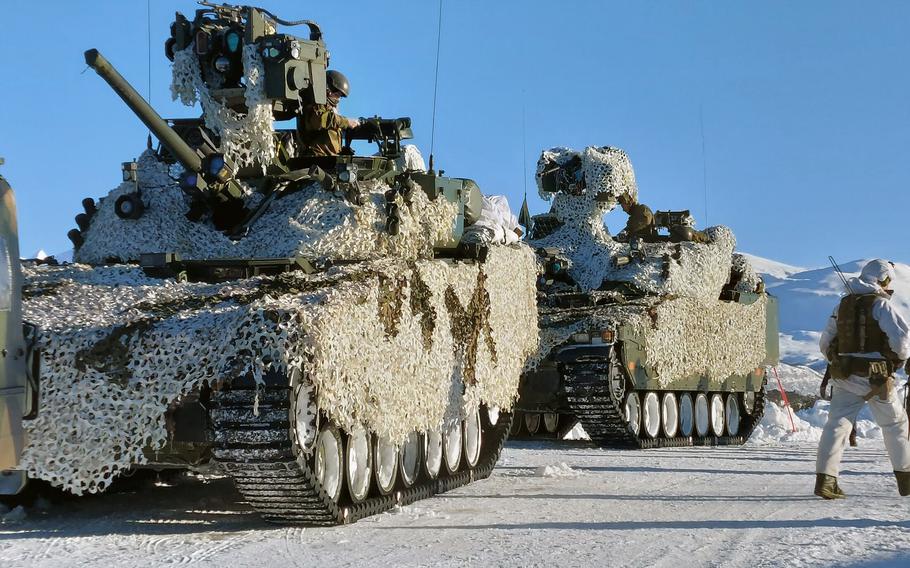
A CV90 infantry fighting vehicle near Bardufoss, Norway, during Joint Viking military exercises with NATO forces on March 8. (Danielle Bochove/Bloomberg)
When 600 Dutch marines sawed holes in a frozen Norway fjord last month as part of their Arctic training exercises, and then took turns deliberately skiing into them, everything seemed to be going according to plan.
But when it came time to claw themselves back onto the ice, in their sodden winter gear, they encountered an unexpected problem. It was too warm.
“Normally the technique is that when you come out, you roll yourself dry in dry snow, but now it was 8 degrees [C, or 46F], so the top layer was completely wet,” said Commodore Jeanette Morang of the Royal Netherlands Navy. “Their clothing froze up.”
Challenges preparing for conflict in a part of the world where temperatures can fall to -60C (-76F) are nothing new. Lack of skis — or the skill to use them — hindered allied efforts to help Norway push back German forces in 1940. The same year, Finland’s Arctic expertise, including the use of skis and reindeer, helped it inflict disproportionate casualties on Russian troops during The Winter War.
But what’s always been tough is getting tougher as climate change causes more extreme weather and temperature fluctuations in an environment that has always pushed soldiers to their limits. Collapsing permafrost, unpredictable ice on frozen lakes and seas — even rain — are creating new challenges throughout the Arctic. At the same time, geopolitical tensions are heightening its military importance as global warming opens the region to new economic opportunities, including lucrative trade routes and untapped natural resources.
NATO’s Centre of Excellence-Cold Weather Operations has seen a surge in demand for Arctic warfare competencies as NATO members have begun focusing more on the north, said Lieutenant Colonel Simen Sandum, deputy director of the organization.
“I think that’s a result of the geopolitical change with Russia and their war in Ukraine, climate change, and the possibilities that opens in the Arctic,” he said. “We now have a huge shift where we have to take into consideration our own protection in North America, and the Northern Atlantic, Northern Europe, where suddenly China and Russia have shifted to be a lot more interested in our areas.”
Norway has long been NATO’s top choice for northern training because of its naturally wide range of conditions: coastal, mountain and inland weather systems as well as Arctic, sub-Arctic and temperate cold. But as Arctic warming accelerates, Sandum says the country, along with much of Scandinavia, is seeing even greater temperature swings, variations in snow conditions and differences between regions.
At -60C, skin freezes in under a minute but overheating can also be a problem, especially if temperatures change quickly. Perspiration needs to be managed; moisture increases the risk of hypothermia and trench foot. Temporary Arctic shelters need to be equipped to dry clothing.
“If you get cold and you get wet, you get even colder,” Sandum said. “And it does something with both the morale, the physical ability of the unit and the psychological ability of the unit to conduct operations. So I fully understand when soldiers say the worst conditions are around zero [C, or 32F].”
When snow gets inside equipment, melts and then refreezes, it can malfunction. Temperatures hovering around freezing are more likely to require chemicals on runways to reduce ice, which can damage the engines of fighter jets unless they’re immediately cleaned.
Assault rifles can jam, said Emma Melby, a soldier who took part in this month’s Joint Viking exercises in Norway.
“Sometimes we have to open it, and just clean it,” she said of her HK416 weapon. “Sometimes we have to warm it.”
Communicating about the effects of climate change becomes much more important in this environment, said Walter Berbrick, an associate professor in the War Gaming Department and director of the Arctic Studies Group at the U.S. Naval War College. That includes sharing granular, operational-level information between allied forces.
Aircraft perform differently depending on air temperatures and pressure, meaning some Arctic runways may need to be extended for warmer, moister air, he said. “Weapon systems and that ammunition will need to be adapted to those extreme temperature conditions and rapid changes in temperatures.”
Mia Leoh, another Norwegian soldier, experienced such a change during the recent Joint Viking exercises when the temperature fell from 5C (41F) to -28C (-18F) in a week.
Mobility becomes trickier. More gear needs to be carried and even food requirements change since colder temperatures require higher-calorie rations. Wet snow is heavier and being wet shortens the amount of time you can stay outside.
“We always check our fingers and feet for frozen damage,” she said. “When we’re running, it’s really hard — we get tired really fast. We’re training in harder conditions to be better in conditions that are more easy.”
Arctic nations with permafrost, like the U.S. and Canada, are experiencing engineering challenges. A report from the Inspector General of the U.S. Department of Defense last April examined the military readiness of U.S. bases in the Arctic and sub-Arctic and concluded leaders were not doing enough to adapt to climate-related changes. Collapsing permafrost and more frequent freezing and thawing of subsurface water can damage runways, the report said, while erosion from flooding threatens roads and fuel deliveries. More violent storms can knock out radar installations.
More extreme, less predictable weather leaves less room for error — every small detail needs to be considered, from remembering where you put your mittens to cleaning the snow out of the tracks in your vehicle before it melts and refreezes, said Sindre Hagensen, a sergeant major with the Norwegian Artillery Battalion with 25 years of military experience.
“We prefer definitely cold, stable conditions,” Hagensen said. “Good old-fashioned winter: It’s easy. Things stay dry.”